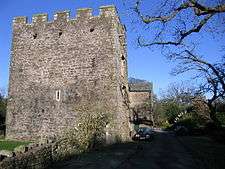Branthwaite Hall
| Branthwaite Hall | |
|---|---|
| Cumbria, England | |
|
Pele tower | |
 Branthwaite Hall | |
| Coordinates | grid reference NY065253 |
| Type | Pele tower |
| Site information | |
| Condition | Intact |
| Site history | |
| Materials | Rubble masonry |
Branthwaite Hall is pele tower in Cumbria, England, considered by historian Anthony Emery to be "one of the best-preserved early houses in Cumbria".[1]
History
Branthwaite Hall was built near the village of Branthwaite and the town of Cockermouth in the mid-15th century by the Skelton family, who acquired the surrounding manor from the Branthwaites by marriage.[2] The new building was constructed from rubble stone with a single tower with a parapet and a spiral-stair turret, with an adjacent hall.[3] The hall was 60 feet long and 42 wide (18 metres by 13 metres), but was largely remodelled in 1604; the new hall is a single space, whereas it was probably originally subdivided, and additional windows were added.[4] Subsequent work was conducted in the 1670s to give the property a grander appearance.[5] The Skeltons held the hall until 1757.[6]
Today
Branthwaite Hall was restored between 1985 and 1986 by the National Coal Board, which converted the property into offices.[7] It is considered by historian Anthony Emery to be "one of the best-preserved early houses in Cumbria".[8]
See also
References
Bibliography
- Emery, Anthony. (1996) Greater Medieval Houses of England and Wales, 1300–1500: Northern England. Cambridge: Cambridge University Press. ISBN 978-0-521-49723-7.
- Pettifer, Adrian. (2002) English Castles: a Guide by Counties. Woodbridge, UK: Boydell Press. ISBN 978-0-85115-782-5.
Coordinates: 54°36′51″N 3°26′57″W / 54.6142°N 3.4493°W
